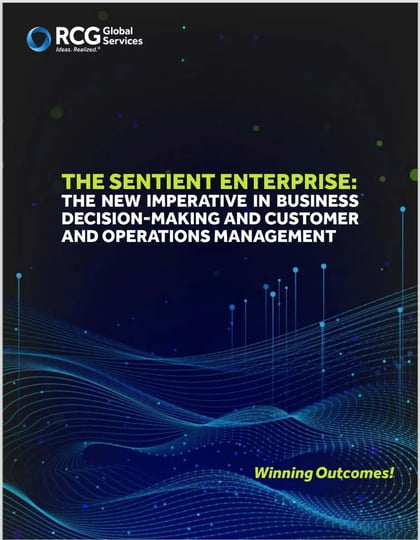Drive Business Results with The Sentient Enterprise
The New Imperative in Business Decision-Making and Customer and Operations Management
Drive Business Results with Intelligent, Real-time Data and Advanced Analytics

Without a crystal ball, it can be difficult to make fast, informed decisions that will affect customers in real-time and lead to winning outcomes.
Streaming real-time data can help move customers along the buyer journey, increase engagement, and ultimately help you outpace your competitors.
3 Use Cases that Explore the Art of the Possible
Intelligent analytics via streaming real-time data and AI can uncover relevant insights using large amounts of data to optimize an organization’s marketing strategy with immediately actionable insights. The possibilities and the valuable outcomes are endless both in marketing, customer experience as well as in all areas of your business model.
It’s really the ability to combine data, algorithms and automation to make high-frequency decisions without human intervention. Why is this important? Fundamentally, the challenge we’re running into in the enterprise is agility at scale: How do you make decisions at the speed of data? Agility doesn’t like scale and scale doesn’t like agility. From Marketing to Supply chain to Finance to Customer Engagement, your business model is likely ripe with opportunity to increase key business metric performance like revenue, share, profit, customer loyalty and cost effectiveness.
If you look at the largest companies in the world, they have so many customers, so many business lines, and they collect so much data, that no single employee can possibly know everything that’s going on at a given point in time. The evolution of the analytics capabilities in the enterprise is going to be a journey, not a one-shot deal.
This e-book explores valuable use cases to help you brainstorm possibilities in your own organization by creating the ability to achieve “business at the speed of now” and driving business results with intelligent analytics and decision-making using real-time streaming data. 2.
Business Outcomes from smart operations
- Lower Operating Costs
- Lower Inventory Levels
- Improve Product Quality or Service
- Decrease Time to Market
- Lower Capital Costs
- Reduce Operational Risk
- Increase Innovation
Additionally, better customer management can yield better insight for decision-making, reduced churn, optimized marketing investment, better targeting and segmentation, and delivering better overall customer experience.
Use Case 1: Digitally Transform Your Business
Marketing Excellence Proximity Marketing and Ad Optimization:
Consumer and retail companies are looking for innovative ways to transform their businesses digitally – a critical step toward competitiveness and enhanced profitability. Those enterprises that fail to cater to specific customer needs to lose out, and customers soon switch loyalties to their competitors. The bottom line is that successful organizations will be Sentient Marketing Organizations. The only way to truly be sentient is to enable real-time, streaming data to drive insight and action.
The good news is that there are key technology enablers that support an enterprise’s digital transformation efforts, including intelligent analytics. Real-time insights and data about how consumers move through their world via intelligent analytics help to better understand and connect with customers.
Organizations are struggling to handle the enormity and variety of data channels, and the inability to correlate these disparate data streams to identify useful insights. Yet, despite ever-increasing data opportunities, organizations are puzzled as to when, where, and how product-specific information should be communicated to customers to move them along a buying cycle.
Enter intelligent analytics via streaming real-time data and AI. This approach can uncover relevant insights from large amounts of data to optimize an organization’s marketing strategy implemented in real-time.
Companies can leverage analytics to become more familiar with customers and their requirements and to optimize communication so appropriate messages are pushed to them at the most opportune time and place.
The retail industry is undergoing rapid changes as the smartphone gives both the shopper and the retailer capabilities they never had before – and even more so as 5G comes online. Shoppers are able to receive information on demand wherever they may be via their smartphone.
A typical example of this is the use of streaming analytics for proximity marketing, incorporating beacons and mobile infrastructure to locate customers and analyze their behavior and enhance their experience by providing them with precisely what they need. This enables organizations to highly customize their offerings based on context, instead of pushing out random product offers.
Streaming analytics helps retail stores track the indoor location of their customers, discover the most attractive product in the shop, send an ‘offer of the day’ when customers within a certain radius, provide offers related to their specific outcomes of interest, suggest other products relative to what they are looking at right now, offer coupons based on customers’ previous purchases, and obtain more advanced statistics for the store manager to refine and redefine business strategies.
Why would you not want to gain a whole new perspective on your potential customers – an entirely new data set? A variety of technologies exist, such as beacons and sniffer tags, that can sense and track Wi-Fi devices every ten milliseconds. When Wi-Fi devices are detected, they capture and encrypt the time, location, and a unique device ID or even an identified app. You can choose to:
- Send that data over existing or dedicated networks to a cloud-based data repository.
- Position and aggregate data for delivery, providing the processed data in the form of a data feed.
- Ingest the data feeds into advanced analytics tools and machine learning models to trigger events, alerts, or notifications and drive better marketing, promotion, and personalization
The location data can even be used to correlate active social media sentiments for potential service interventions.
There are many potential benefits beyond real-time customer promotion and personalization.
Location and contextual data can be used to create better customer experiences; create innovative new data-based products for your business; make more informed decisions in complex scenarios; carry out effective monitoring and analysis; optimize retail operations; understand customer behavior across different properties; detect even the smallest change and trigger immediate action; and extend your solutions to analyze the past, present, and the future.
Intelligent streaming analytics elevates the product recommendation process by providing suggestions not just based on similar customers but also based on the customer’s purchase history, current seasonal trends, and product combinations that are not intuitive, yet can be found through data mining and machine learning.
Benefits are achieved by correlating behavior like real-time browsing data with summarized historical data such as a customer’s buying history and personal details as well as seasonal trends, inventory status, current promotions, and product correlations. This real-time streaming data, correlation, and analytics results in intelligent recommendations that have a higher purchase probability based on the customer or the current context.
Digital Ad Optimization Online and In-Person at the Point-of-Sale
Most enterprises struggle to achieve effective conversions through their digital marketing strategies as they cannot optimize ad placement contextually in real-time. Hence, most organizations rely on the static distribution of their digital marketing budgets to blindly place pre-determined amounts of different advertisements through multiple social media channels without being able to optimize ad placement in real-time based on which ads and channels more conversions.
By employing streaming analytics for digital marketing, enterprises can dynamically decide when and how to bid for digital ad space based on market penetration, real-time trends, purchase behavior, and available budgets.
Digital signage content can even be customized and served to a customer’s position based on their profile and behavior data.
Streaming analytics seamlessly solves this issue by correlating online user views/clicks and even real-time in-person omnichannel shopping behavior with user demographics on social media and available marketing budgets to make advert bidding decisions within milliseconds. Ads can then appear on the web page that the target customer is currently viewing within an average human reaction time.
As we can see in these examples, when we enable real-time customer location intelligence with machine learning models, we can offer real[1]time marketing interventions that consider the customer’s actual location as they move through the area. We can also use data for other purposes like digital ad optimization.
Implementations can include omnichannel interaction on mobile, in-app, and in-store digital signage and even menu displays.
We can even alert a sales associate to make an informed intervention. Analytics has become vital to improve customer experience, increase market reach, optimize budget spend, enhance business processes, and find and eliminate anomalies. All these eventually translate to improved revenue for any business.
Consumer industry players can particularly benefit from analytics. It enables them to communicate more effectively with their customers in an era where customers are more informed and respond better to customized marketing efforts. Moreover, streaming analytics provides organizations with useful insights into customer behavior, which can help them refine their marketing strategies.
Use Case 2: Customer Experience and Safety
Monitoring and managing social distancing and capacity when workers and Customer Expect a Safe Experience
As we begin re-opening food, drug, and DIY stores and consumers are going to even more places, assuring proper social distancing in public remains essential. The ups and downs of the pandemic surge only exacerbate the situation. The moment people return to your facility, they must be able to visit safely and get a clear signal that your brand is concerned about their well-being. It would be best to assure your customer that you’re doing the best to implement the CDC and other guidelines on social distancing. However, it is not easy, and for many workers, this can cause undue stress and concern.
The moment customers return to your location, they must be able to safely shop, dine, experience in-person services, and get a clear signal and reassurance that the brand is concerned about their well-being.
Retail stores and other locations where people gather on-premises are considering a range of different measures to promote customer and employee safety. What is the best way to do so besides “guestimation” and inaccurate manual counting? How do you demonstrate to local agencies and the public that you are serious about safety and reducing the spread of COVID-19? How can you provide “proof” of actual customer counts and locations in real-time and retrospectively?
Customer location intelligence to manage social distance provides many benefits, including:
- Enable safe shopping in stores, at restaurants, working out at a gym, going to church, hospital or clinic, or even enjoying a theme-park or trip aboard a cruise ship
- Comply with government, industry and internal standards for safety and social distancing
- Mitigate confusion for store management and staff because standards may vary from state-to-state and store-to-store
- Mandate external and internal compliance that may require monitoring and reporting on conformance to standards
- Reduce risk by providing actual data on how your policies and practices are being implemented and maintained
- Address locations of concern where social distancing policy and rules are being violated
As you can see, using streaming data and basic rules or algorithms, you can use customer location technology to help prevent COVID spread and provide your customers and employees reassurance that your brand is doing everything it can to keep them safe.
Use Real-time Capacity Management
Using proprietary real-time customer location technology provides customer insights for operational and marketing deployment that can be used to address key concerns about capacity management, real-time, and across multiple locations. This technology tracks specific location triangulation from sensors more accurately and better than using cameras and counting devices.
Use Case 3: Customer Value with Connected Products
Create a seamless experience and greater value to make your business stand out – an example of the connected vehicle
With more than 30 billion things connected to the Internet, IoT presents a significant challenge and opportunity for enterprises to ingest, process, manage, store, and drive insights from all the data generated by connected devices and assets. Take the case of auto manufacturers and dealers and even car rental agencies. At most auto dealerships, services is the main contribution to profit as well as the increasingly elusive and business-critical customer loyalty.
Automotive Repair & Maintenance Service Market
Consider also that the automotive repair & maintenance service market is estimated to reach USD 810.30 Billion by 2026.
Last year, dealerships wrote more than 310 million repair orders, with services and parts totaling more than $116 billion. Those are some definite hits to driving consumers’ or any vehicle fleet owners’ wallet book.
At the car dealer, the service advisor is usually your first and primary contact. The service advisor is responsible for understanding what needs to be done to your vehicle — routine maintenance or addressing a specific concern.
This is a critical reactive step in the process because the service advisor must interpret and note these concerns on the paperwork in terms the service technician will understand.
Most service advisors will repeat all problems and services requested in a concise form to ensure that no miscommunication has occurred. Upon the customer’s sign-off of the estimate for service, the paperwork is distributed to the dispatcher for routing.
But, this is reactive and inefficient. It doesn’t identify service opportunities that are real-time and location and vehicle specific.
It is time for something different.
Enter the Connected Vehicle
With real-time data streams that include vehicle performance data and location and driving patterns, it is possible to identify problems before they manifest, to identify sub-standard performance that can be tweaked with some proactive maintenance, and to save hassle, miles per gallon performance and larger, unwanted bills.
- Behavioral Data is generated by, or in response to, the driver’s use of the vehicle. For example, telematics data is relayed about speed, steering, braking, and fuel[1]efficient driving. It can even be used to issue alerts when data suggests driver fatigue.
- Diagnostic Data results from the ability to access a vehicle’s data, enabling car dealers or rental agencies to assess a vehicle’s health and notify drivers when service is required with in-car voice communication.
Not only can the alerts and use of machine learning for predictive maintenance identify when and what type of proactive intervention is needed based on actual vehicle performance, but the entire process of enacting a service event can also be triggered and automated from scheduling to check-in to pick-up.
Value creation for both the owner/driver and the dealer or agency in terms of fuel and maintenance can be tracked and articulated so all parties can understand the impact. There are many benefits, including:
- Improve vehicle performance
- Reduce downtime
- Avoid unnecessary costs
- Enjoy proactive, hassle-free customer engagement
For rental agencies and other fleet owners, the dilemma is often to cut costs while also providing the services necessary to maintain and grow the customer base and provide better service.
This real-time predictive intervention translates to real savings and efficiency while helping assure maximum uptime of the vehicle asset while lowering total vehicle costs by avoiding some more expensive repairs down the road.
Intelligent vehicle management and automated service using actual location data with GPS and real-time performance monitoring are disrupting the world, and it should. We are only beginning to realize what is possible real-time data and machine learning to drive efficiency, cost-savings, revenue opportunity, and genuinely better customer experience.
Drive business results with intelligent, real-time data and analytics

We can help you to:
- Drive business results with intelligent, real-time data and analytics
- Reduce time to market for new products and services
- Increase the productivity of people and processes
- Acquire new technology skills more quickly Improve knowledge management & resilience
- Optimize costs and use of resources
- Gain a competitive advantage
- Establish momentum and move the needle
The Sentient Enterprise is the new imperative in business decision-making and customer and operations management. Let RCG help you to uncover relevant insights from large amounts of data to optimize your strategy in real-time. Learn more about Business at the speed of now driving business results with intelligent analytics and decision-making using real-time streaming data.
#WinningOutcomes!
Download a PDF version of this ebook by filling out this form


